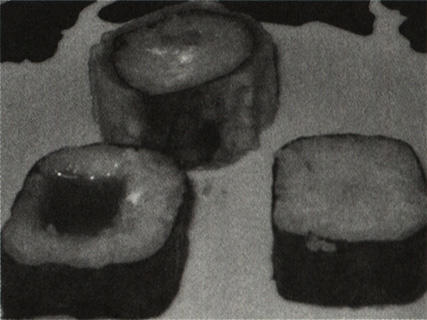Gourmand Dietary Culture
- TOP
- ESSAYS
- Gourmand Dietary Culture
- Red Bean Paste Seaweed Roll
Red Bean Paste Seaweed Roll
vesta No. 71
Red bean paste seaweed roll [norimaki] (left), mango roll (right), tempura sushi made of crab stick (back). Photograph by author.
Let's start from the origins of my nickname, Professor Gourmand.
Me, I'm a cat.
I don't have a name yet...
[...]
My owner is called Shakuri Gachoan Koji Chinbotsutei... it's a strange name.
I think you can tell from his name, but he's a good-looking guy. He's a larger, middle-aged guy.
I don't really know what I'm doing. It seems I'm writing a bunch of stuff...
There are two people always coming to eat at my owner's place.
One of them is called Taishokukenmeitei, which means a big eater and drinker, a "gourmand." He looks pretty young. He has a long beard reaching down to his chest, and comes across quite relaxed. As his name suggests, he loves to eat and drink all the time.
The other is called Ryōsaikaigetsu, which means something like cool-pure-jellyfish. His name sounds quite chilly, and he's handsome, with pale colouring, but seems to be a bit weak-willed.
Both of them, unlike my owner, are serious anthropologists. They travel all around the world researching all kinds of things.
This is the opening passage of Ethnology of the Human Museum (Human Nature and Food) (Kobunsha, 1977; reprinted Bunshunbunko, 1986). It's a book that reflects on human nature and food in the world from the perspective of a cat, in the style of Natsume Sōseki's I am a Cat. It came out of three friends sitting around in high spirits, drinking at the house of Professor Shakuri.
Mr. Ryōsaikaigetsu, or Mr. Cool-pure-jellyfish, is actually Toshinao Yoneyama. Shakuri Chinbotsutei is actually Sakyo Komatsu. And Mr. Taishokukenmeitei, or Mr. Gourmand; well, that's me. Komatsu writes from the two perspectives of Professor Shakuri, and his cat. The dialogue between the characters is written and edited in a humorous way.
Mr. Jellyfish: In Christianity, there are the Seven Deadly Sins. There's "murder," "falsehood," and "lechery," then there's "envy," "pride," and "sloth," and then there's "gluttony."
Mr. Gourmand: Aside from murder, I'm guilty of all of them (laughs).
Mr. Shakuri: Your "gluttony," Mr. Gourmand, is about seven people's worth (laughs).
The book is full of anthropological discussions of human nature and food in the world, told in this kind of way.
Living up to his nickname, Mr. Gourmand has encountered many strange foods while traveling the world eating and drinking. He would like to introduce you to the new-style sushi he tried last year in Brazil.
There was a cabinet minister who, when he saw sushi and yakitori listed up next to each other on a menu in a Japanese restaurant in the U.S., decided that in order to promote "real Japanese food" there should a certification system for Japanese restaurants abroad. But, in Brazilian restaurants it's not that unusual to be able to pick up sushi at the same place you can order Brazilian barbecued meat. "Sushi corners" are starting to pop up in restaurants that specialise in buffet-style Brazilian barbeque. I've enjoyed eating Brazilian barbequed meat, whilst drinking Pinga, a distilled liquor made from fermented sugarcane.
In the sushi corner, there was salmon-rolled sushi, California rolls, and sushi I didn't recognise: seaweed rolls [norimaki] filled with mango fruit flesh, seaweed rolls filled with red bean paste, seaweed rolls filled with crab sticks and mayonnaise, rolled in a light batter and fried tempura-style. The acidity of the vinegared rice and the sweet-sour of the mango didn't go badly together in the mango rolls. The red bean paste rolls were completely sweet. Red bean paste is made by Japanese-Brazilians. It has been over 100 years since Japanese immigrants began to settle in Brazil. The crunchy outside of the tempura sushi had an unusual feel in the mouth.
I put them in my mouth hesitatingly--and while I can't say they were the most delicious thing I've ever eaten, I ate them without resistance. They were a palette cleanser after the fatty taste of the main food, barbequed meat, and went well with the high-percentage alcohol, Pinga.
According to Americans living in Brazil, the old style of Brazilian barbeque joint would just have a self-service salad bar to go alongside the barbequed meat skewers, which the waiter would bring over and cut off for you at your table. A sushi corner has only become a thing at Brazilian barbeque places in the last 4 or 5 years. The sushi corner has only become popular because many Brazilians now like to eat sushi. Compared to Japanese specialty restaurants, the sushi is cheaper. The people working in these barbeque joints are also usually Brazilians.
Friends who make sushi professionally would inevitably say that mango rolls, red bean paste rolls, and tempura rolls are not real sushi. In terms of a Japanese aesthetic, the smell of barbequed meat doesn't go with sushi.
But the ones eating it are Brazilians. It's normal that food commodities adapt to the culture of those eating them. Japanese food that has adapted to another culture might be criticised as "not right." But I think we should highly celebrate the evolution of culture that was born in Japan away from a Japanese tradition.
Translated with support by Agency for Cultural Affairs, Government of Japan

